Today (September 23rd) is the main reason we embarked on a Scottish adventure – a special trip to help us celebrate our 40th wedding anniversary, and over breakfast at the Clan McDuff Hotel in Fort William, Scotland, we reminisced about September 23rd, 1978.
I had spent the previous night at Duffy’s Motor Inn in Amherstburg, Ontario, with my friend George Semple, one of my groomsmen. George and I had breakfast at a food counter in the mall, before going on a 10 km run along the Detroit River. From there we headed to the tennis courts for a marathon game (George later claimed he was trying to tire me out so I wouldn’t be able to “perform” on my wedding night! He didn’t, tee-hee). One thing he did accomplish was to hit a serve with such wicked spin that it bounced up and knocked my glasses off, bending them in the process. There were many “out-takes” of wedding pictures where my hand was reaching up to push my glasses back on my nose (that’s me with my mom and dad in the picture to the right)
there we headed to the tennis courts for a marathon game (George later claimed he was trying to tire me out so I wouldn’t be able to “perform” on my wedding night! He didn’t, tee-hee). One thing he did accomplish was to hit a serve with such wicked spin that it bounced up and knocked my glasses off, bending them in the process. There were many “out-takes” of wedding pictures where my hand was reaching up to push my glasses back on my nose (that’s me with my mom and dad in the picture to the right)
Meanwhile, Mary had spent the night at the Bridgen family home on the farm where she  she had grown up, about three miles outside of town. She recollected that she was very calm and happy as she thought about the day ahead, while one of her attendants (Heather Murray) was running around looking for a paper-bag to breathe in, wondering how Mary could be so calm. The picture to the left is taken just outside the house, and the women to the far left is Mary’s sister Jane. The young girl to the far right is Jane’s daughter Colleen who was our flower girl.
she had grown up, about three miles outside of town. She recollected that she was very calm and happy as she thought about the day ahead, while one of her attendants (Heather Murray) was running around looking for a paper-bag to breathe in, wondering how Mary could be so calm. The picture to the left is taken just outside the house, and the women to the far left is Mary’s sister Jane. The young girl to the far right is Jane’s daughter Colleen who was our flower girl.
We were blessed with a beautiful sunny day, and our wedding pictures were taken at Fort Malden, located right on the Amherstburg waterfront looking out over the Detroit River. The one below is one of our favourites.
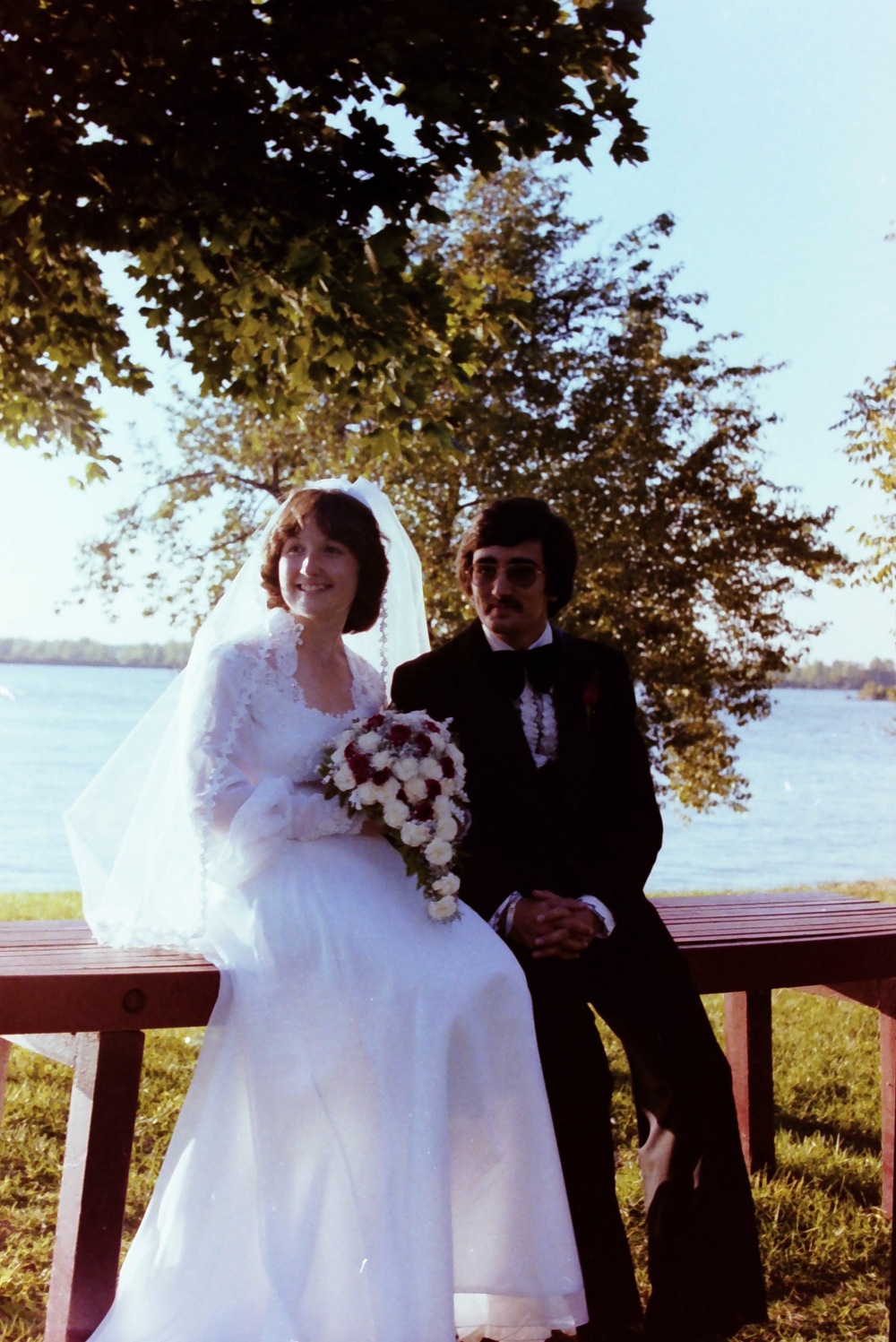
We’ve come along way since then. Three cross-Canada moves. Raised two amazing daughters. Welcomed two wonderful son-in-laws into our family. And, in recent years, added two grand-children into the mix. We even started our own company 21 years ago, which meant we are hardly ever apart, and that constant togetherness has followed us into retirement where we never seem to get tired of being with each other. We are truly, truly blessed.
Today, our plan was to take a leisurely drive south toward the town of Oban – a stretch of driving that would cover about 45 miles and move us ever closer to our final destination of Glasgow/Paisley (for our return flight home on Wednesday, three days from now). Our first stop though was at the town of Glencoe, about 16 miles south of Fort William.
The village of Glencoe has a population of 375 and is located at the foot of the Glencoe Mountains where the River Coe flows into Loch Leven. This village was one of the MacDonald clan settlements at the time of the Glencoe Massacre ( I referenced this dark episode of Scottish history in my Isle of Skye blog).
There is a traditionally thatched building that serves as the Glencoe and North Lorn Museum and it tells the story of crofting, local clans and the history of the area (the small building in the bottom left picture above).
While it is indeed a quaint little town, our reason for stopping by is that Glencoe and the surrounding area has been seen in numerous films, including Harry Potter and the Prisoner of Azkaban (as the home of Hagrid), and the 2012 James Bond movie Skyfall. (note: In Ian Fleming’s original novels, Glencoe was the birthplace of James Bond’s father Andrew Bond).
In order to visit the location of the Harry Potter movie shoot, we had to negotiate a  narrow, twisty 2.5 mile road through the woods to the Clachaig Inn. Along the way we passed people on horseback, and quite a few groups of hikers on foot which quite surprised us. The phrase “in the middle of nowhere” seems to get used a lot in casual conversation, but in the case of the 300-year old Clachaig Inn, it was an apt description. If you did not know it was there, you would never accidentally stumble upon it. Yet, it has a world-class reputation and when I spoke to the desk clerk upon our arrival, the 23-bedroom Inn and surrounding cottages were fully booked through the end of October and into early November.
narrow, twisty 2.5 mile road through the woods to the Clachaig Inn. Along the way we passed people on horseback, and quite a few groups of hikers on foot which quite surprised us. The phrase “in the middle of nowhere” seems to get used a lot in casual conversation, but in the case of the 300-year old Clachaig Inn, it was an apt description. If you did not know it was there, you would never accidentally stumble upon it. Yet, it has a world-class reputation and when I spoke to the desk clerk upon our arrival, the 23-bedroom Inn and surrounding cottages were fully booked through the end of October and into early November.
Filming for the third Harry Potter film, Harry Potter and the Prisoner of Azkaban, took place on location in Glencoe in May and June of 2003 , and it is behind the Clachaig Inn that we spotted a familiar looking backdrop from that film, and subsequent Harry Potter films.
First, here are two pictures from the movie – Hagrid’s Hut, complete with pumpkin patch and smoking chimney, the sundial and the turreted gatehouse, and the Bridge to Nowhere which sat neatly on the hillside above Clachaig Gully.
Hagrid’s Hut was built right across the road from the Clachaig Inn, which is the area you can see in the pictures (below) taken this morning.
There are no signs commemorating the movie, and with the sets removed and the hillsides returned to their natural state, there is little evidence of the excitement that descended upon this quiet corner of the glen for a few weeks in the summer of 2003.
I did chuckle at one particular sign at the front desk of the Clachaig Inn, and it speaks directly to the historical hatred of the Campbells in this part of Scotland, relating of course back to the Glencoe massacre.

Leaving the Clachaig gully a few miles further along the road, we reconnected with the A82, a road that cuts through Glencoe Valley, and takes visitors on another one of the “scenic drives” singled out by Tourism Scotland.
It was indeed a beautiful drive but I was clearly not the only one who had “book-marked” this stretch of highway, as the traffic was heavy and steady in both directions. As a result we decided to take a pass on two side trips that I’ll mention here, purely for those who might be using this blog for future travel planning themselves.
The first one is a scenic drive to Glen Etive. Following the A82 towards Tyndrum, the road climbs steadily up through the glen where the valley is at its narrowest, and on to a turn where everybody stops to photograph the craggy heights of Buchaille Etive Mor (seen in our pictures below)
This turns leads on to a single track road that takes you down Glen Etive to the head of Loch Etive some twelve miles in. James Bond fans might recognize the scenery from Skyfall.
The second side-trip we took a pass on was to Castle Stalker. It is the “star” of the closing scenes of Monty Python and the Holy Grail (seen below in a stock photo and in an image from the movie itself).
Castle Stalker involves another tenuous stretch of driving, in this case along the A828, and is located about 18 miles north of Oban. I was quite interested in seeing it (how could I not be given how Python-mad I am?), but as we got to the cross-road leading toward the castle, there was a steady stream of traffic heading that way, including a disproportionate number of coaches. Twenty-six days into our trip, we are “done” with crowds, and having seen how busy other Python sites were (Doune Castle in particular), we slid Castle Stalker into our “next time” folder, and moved on toward Oban.
Just before reaching Oban, we followed the signs to Dunstaffnage Castle, the former stronghold of Clan MacDougall. It is where Jacobite heroine Flora MacDonald was believed to have been held prisoner for her role in helping Bonnie Prince Charlie evade capture by the Redcoats following his disastrous defeat at Culloden in 1746.

It is located on an immense rock that overlooks the Firth of Lorn and is one of the oldest stone castles in Scotland, dating back to 1220. It was built at the height of the battle between Scotland and Norway for control of the Hebrides and was even once besieged by Robert the Bruce during the Wars of Independence.
 The size of this castle caught us by surprise because it was not until we emerged from a beautiful tree-lined walk along the water that we came upon the formidable stone curtain you see in the picture above. As we approached it we couldn’t see how we could get inside as there were no obvious openings except for some narrow arrow-slits and gun-holes.
The size of this castle caught us by surprise because it was not until we emerged from a beautiful tree-lined walk along the water that we came upon the formidable stone curtain you see in the picture above. As we approached it we couldn’t see how we could get inside as there were no obvious openings except for some narrow arrow-slits and gun-holes.
We found the entrance gate halfway up one of the side walls in a spot that was originally accessed by a bridge that could be lowered from the inside of the castle. The stone staircase I’m standing on in the picture to the right, was added in the 1720’s by the Campbells who had wrenched control of the castle from the MacDougall clan in the mid-1400’s (there’s those Campbells again).
Upon entering the castle, we found ourselves in an inner courtyard and standing among the remains of the great hall. The tall building in the pictures below is referred to as the “new house”, originally a gatehouse but converted to a home in 1725.
We were able to climb an inner staircase which led up to a fairly intact wall-walk used by the garrison to survey and defend the castle. It afforded us a terrific perspective looking back down into the castle grounds, while at the same time gifting us with panoramic views across the Firth of Lorn to the distant peaks of Morvern and Mull.
Access to the upper floors of the “new house” was via the wall-walk, and we were able to get a sense of the size and scope of the inner rooms. The floors were inter-connected via spiral staircases in two of the four corners. The rooms variably served as reception areas, dining rooms, private suites and bedchambers.
The top floor (the picture above of Mary standing with outstretched arms) was the servant’s quarters, and offered the best views through the dormer windows seen in the picture below.

Much of the original castle was devastated by a fire in 1810, but the “new house” remained occupied until 1888, when the last Campbell on the grounds turned it into a tea-house for entertaining guests. Plans to restore the castle have come and gone over the past 100 years and as of 1958, the Campbell’s handed it over to state care.
In the woodland behind the castle there are the remains of a chapel that was built by the MacDougalls in the early years of Dunstaffnage. As you can see from the pictures below, it is a long single space, perhaps 60 feet in length, and Mary can be seen peering through what was once an elaborate doorway.
Little is known about the chapel other than it was a family chapel, and never a parish church.
I mentioned the beautiful tree-lined walk along the water connecting the parking lot to the castle itself. The picture below illustrates what I was talking about.

After getting back on the road, in just a matter of minutes, Mary had us looking for a parking spot in Oban, a seaside town of around 9,000, nicknamed “the Gateway to the Isles”. A number of ferries depart from its main port and travel to various islands of the Inner and Outer Hebrides. A fairly large ship was pulling away from the dock as we cruised the main street.
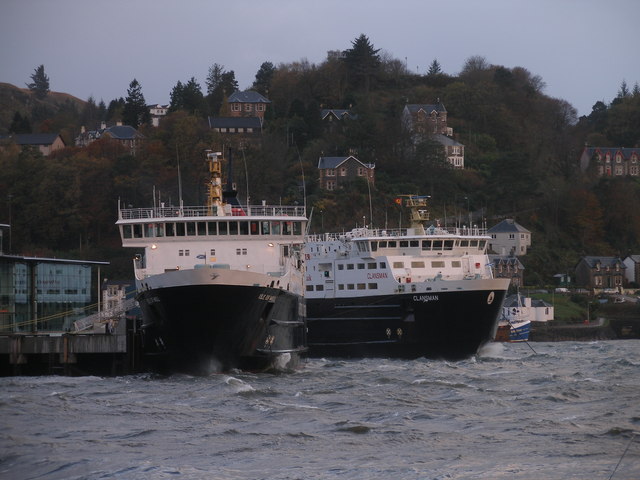
It was a sunny, cool, windy Sunday afternoon, and the streets and sidewalks were absolutely packed. We had to drive to the far end of town before finding a spot. It did seem like it was tailor-made for us though. Check out the sign on the store about our little Vauxhall.
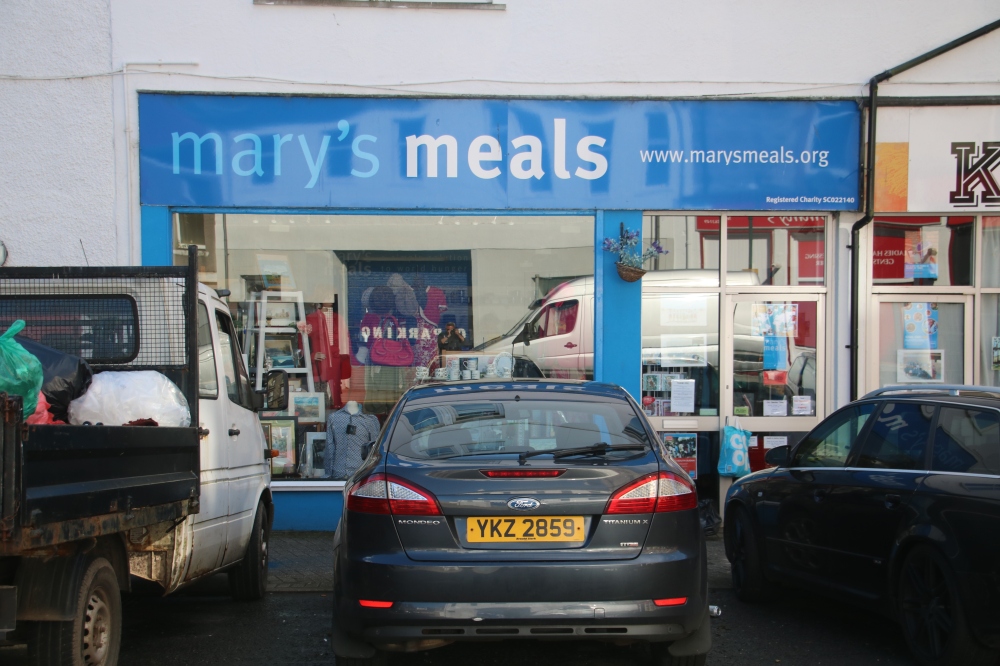
As we walked away from the car to begin a two-hour walkabout, we spotted McCaig’s Tower perched high above the town. It is an 1897 “make-work” project funded by local banker John Stuart McCaig to provide work for local stonemasons and create a lasting monument to the McCaig family. I had known of its existence before we arrived in Oban, and Mary agreed with my suggestion we should take a drive up to the top before leaving the area.

We wandered the streets looking for a cafe or tea-shop where we could grab some mid-afternoon treats, and we struck out everywhere we tried. All the outdoor spots were taken up by people enjoying the sunny day, and there were line-ups in every other “decent” place we tried. As an example, one I had penciled in on my “check-it-out” list, was the Oban Chocolate Company – What do you expect? It sells gourmet chocolates! And it also had a tea-shop/cafe associated with.
While it looks like there are tables available, there were multiple groups in line waiting to scoop them up, and I couldn’t even get near the chocolate line-up. Damn!
The picture to the left was taken as we made our way back to the car. We debated 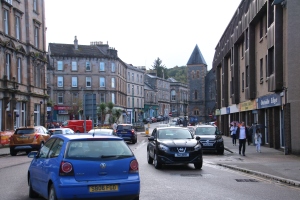 making the steep climb up to McCaig’s Tower on foot, but I’m afraid we were just a little too tired. It would have involved a very steep half-mile walk with a 144-step staircase at the end for good measure. We wussed out, and opted to drive instead.
making the steep climb up to McCaig’s Tower on foot, but I’m afraid we were just a little too tired. It would have involved a very steep half-mile walk with a 144-step staircase at the end for good measure. We wussed out, and opted to drive instead.
As noted earlier, the tower was a make-work project paid for by a local banker, John McCaig. He was an admirer of Roman and Greek architecture, so he had elaborate plans drawn up for a structure based on the Colosseum in Rome. His grandiose idea also called for a museum and art gallery with a central tower to be incorporated, adorned with statues of himself, his siblings, and his parents. His death brought an end to the construction with only the outer walls completed.

The empty shell is a popular spot for quiet lunches, reading, and gazing out across Oban Bay to the nearby islands of Kerrera, Lismore and Mull, and you can see why from the picture below.

On our way to Oban after visiting Dunstaffnage, we passed through the village of Connel, a pretty spot on the shore of Loch Etive. The most noticeable feature in the village is a large, single lane, cantilever bridge that spans Loch Etive. Originally built as a train bridge in 1903, after the branch line closed in 1966, the Connel Bridge was converted for the exclusive use of pedestrians and vehicles, but as you can see, it is just wide enough for one vehicle.
Looking for a place to eat after our failed attempts in Oban, we decided to check out the food options in Connel, and in the process found the Ronebhal Guest House, a spot that people had raved about on-line. When I checked it out, a notice popped up telling me this place was normally sold out, but due to a last minute cancellation, a “room with a view” was available for one night only. Bonus!
With our accommodation set for the night we stopped in for an anniversary dinner at the Glue Pot Restaurant adjacent to the Oyster Inn, in Connel. You can see the imposing structure of the Connel bridge looming over the back of the Inn.
The Inn was originally the 18th century ferry house for the Connel Ferry, prior to the bridge being built. The Glue Pot restaurant was built to get around licensing laws in Scotland in the 1850’s. Local’s were not allowed to drink in public house’s on Sundays, but travelers being served in an Inn or Hotel could be. So, canny locals got around the law by drinking in the hotel pub/restaurant and “posing” as travelers.
The menu was packed with great seafood dishes, and we settled in for a nice dinner sitting beside a warm peat-fueled fire. We even posed for a 40th anniversary picture courtesy of the bartender.

After dinner, we attempted to find the Ronebhal Guest House using Sid (our GPS), and she had us going all over the place – everywhere except where it was – three doors down from the Oyster Inn, but in the opposite direction from which we’d be searching (hand slapping on forehead). What a great place this turned out to be, and our room was the one in the top right in the picture below.

And this was our room and the picturesque view of Loch Etive we had.
And this is Mary watching in amazement as a thundering wave of rain came across the Loch out of nowhere…..and you can see in the left side window as the sun is following behind the rain.
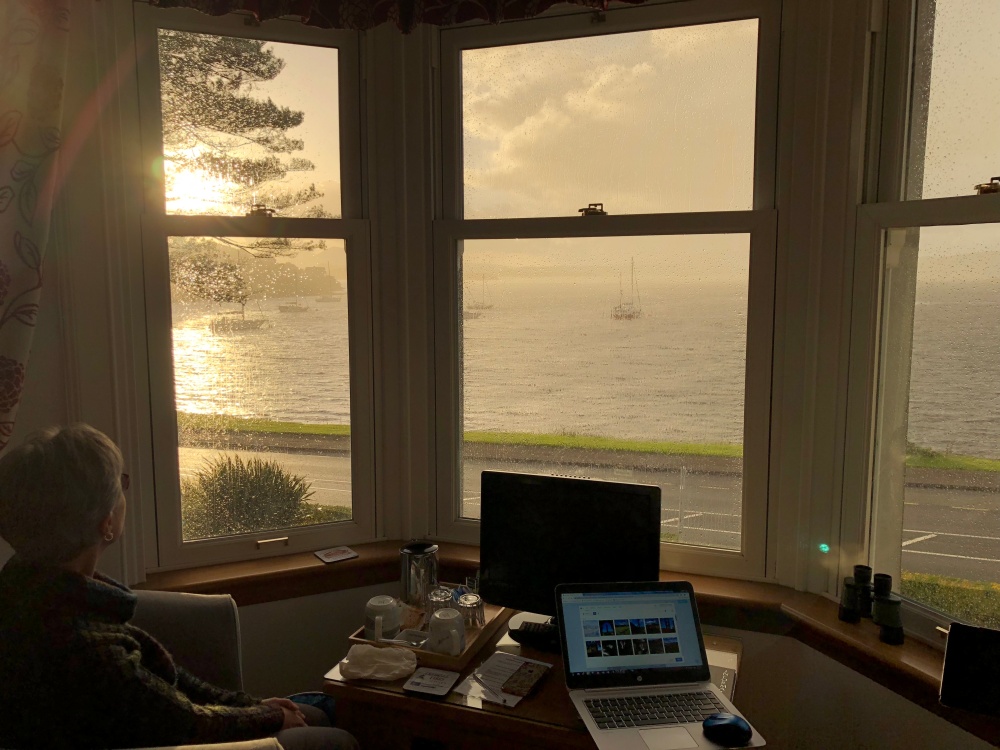
And this is the glorious sunset we got to see from our room.

At various points during the day, we looked at our watch, calculated EST , and we would reflect on what we were doing at that same time 40-years ago. We smiled and laughed as we replayed some of the events of that day as well as remembering some of the people we shared it with. The most enjoyable part was that we also talked about some of the wonderful things that have happened to us in the 40 years since.
As the sun set for today, we held hands and wished and hoped for many, many more to come.

































Great anniversary day but am surprised you didn’t get a meal at “Mary’s Meals”. It would have just seemed be destined for you! I am constantly surprised at the numbers of tourists you have encountered. It seems Scotland tourism is flourishing!
LikeLike
Unfortunately Mary’s Meals was closed, and we’ve been surprised how busy it has been too.
LikeLike